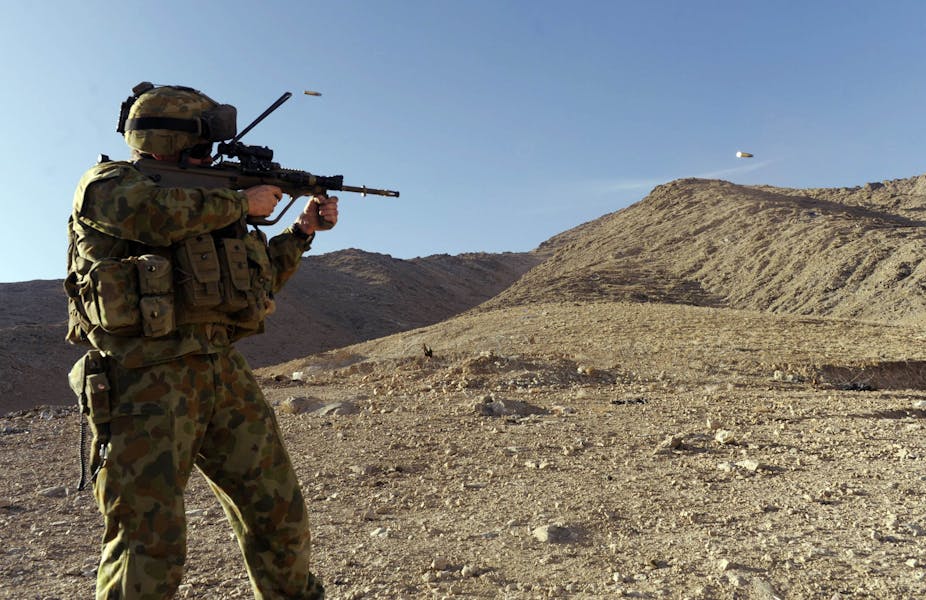Defence Minister Stephen Smith has announced the Australian Defence Force will open up full employment opportunities for women.
In a decision made by Cabinet on Monday night, with the full support of the Defence Chiefs, the last 7% of “combat” roles will be available for women to serve. The ADF has outlined a five-year transition plan.
For supporters of the policy, the move is an historic one. Australia becomes one of only four nations globally, along with Canada, New Zealand and Denmark, that offers women the same employment opportunities as men within the Defence Forces.
Women will now be able to serve in the artillery, as navy clearance divers, airfield defence guards, infantry and the Special Air Service Regiment. As long as they meet the requirements, and demonstrate the capacity.
Masking conservatism?
Enthusiasm for the policy begins to slow down around questions of women’s capacity to execute the role. Heated responses to the policy move argue that women will not be physically able to make the cut.
Do these arguments hold water or do they just hold women back? Is the question of capacity a mask for cultural conservatism?
Those resistant to the notion explain women will not be able to meet the endurance requirements, carry the heavy packs and weapons, or manage the dirty, dangerous work of the combat trades.
Psychological concerns focus on the way women will disrupt the combat unit. The “die hard grunt” will argue that a woman cannot be trusted to do the job properly, that there will be a need to constantly scrutinise her work.
And some say women have aberrant hygiene needs that a group of warriors could not possibly manage.
Dead Diggers
Capacity arguments are irrelevant to the policy reality. No military personnel can fill these trades if they do not meet the physical standards required.
And the fear is misplaced. There will not be a horde of women coming over the top to infiltrate these trades. Just as many men reject the trades of combat, so will many women.
Other Defence Forces who have taken this step still have marginal representation in these roles some years after the gender barrier was lifted.
Subsequently, arguments such as that made by the Executive Officer for the Australia Defence Association (ADA) Neil James reflect a rendezvous with the ridiculous:
“The issue they don’t appear to be willing to address is the risk of disproportionate casualties. Someone, is going to have to face the people of Australia and explain why we’re killing our female diggers [soldiers] in larger numbers than our male diggers.”
Women in combat are as old as war itself
It seems if you resist an idea, there are plenty of ways to make an argument against it.
Women have been involved in warfare in the past and are engaged in warfare now. In the 1941 Yugoslav liberation war, around 100,000 women were active combatants. Women also fought alongside their male counterparts in the Algerian liberation war.
Today, women serve in roles in Afghanistan that come under fire, and indeed numerous women have been killed in action in the British, Canadian and United States forces.
The capacity arguments draw on the authority of science to thinly veil a cultural resistance to women serving in combat roles. And it is indeed cultural barriers that present the biggest challenge to women wanting to move into these male realms.
Can a hyper-macho culture be changed?
In Australia currently, about 86% of the ADF is male. Apart from support roles to the combat trades, combat roles are exclusively populated by men. These are male domains.
The reality that very few women will move into these roles is both a reason to keep our feet on the ground but also a reason for concern.
The infantry battalion, for example, is a profoundly hyper-masculine environment. The infanteer embodies a warrior ethos scaffolded by a logic of brotherhood.
In this context, men who do not meet the cultural standards of the group are ostracised.
Given the way in which incidents like the ADFA Skype affair or the HMAS Success “Love Boat” scandal persistently arise, this is the barrier that must be most seriously addressed.
These incidents are marked by male predatory sexual behaviour and represent an institutional culture that does not yet provide genuine safety for women that serve in the ADF.
This is the real challenge for women moving into these domains, and this is the biggest challenge for the ADF in genuinely opening up full employment to them.
This challenge will need to be met by the provision of effective equity mechanisms, and complaints services and procedures. The attitudes the Command have demonstrated in taking this policy direction must become an institutional disposition.
Zero tolerance for discrimination
So often, the prejudice of men is tacitly condoned among the ranks and local leadership. From section, to platoon commander and upwards, the ADF must embrace a genuine policy of zero tolerance of men’s discriminatory practices.
Opening up full employment in the ADF is so much more than an argument about capacity or even military effectiveness. These ideas are important when argued sensibly, but this move is about cultural change.
The ADF as an institution must modernise to maintain organisational effectiveness. It must also work hard to correspond to broader community standards.
Opening up full employment for women is just the start.

